Tim Flanagan's Blog, page 31
February 1, 2013
Review to die for…
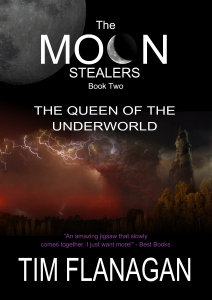
An incredible review from America:
“This book is just as amazing as the first. I have to say that I think Tim Flanagan is a J.K. Rowling in the making. He can paint with words, and he can draw emotions from the reader’s heart. He has the amazing ability to draw you into a mystical and magical world filled with amazing creatures and characters that will fascinate the reader. His story lines are unique and truly refreshing. What I loved about this book was the action, both emotional and physical. The battle scenes are incredible! I also found the moral messages really important: Different races working together to battle a common enemy, and how nature surrounds us and is alive. I found myself wondering what the trees and plants around me were thinking! Then there was a quote that I loved: ”The size of a soldier does not reflect his determination and skill on the battlefield or dictate how great his heart is”-Lady Flora. This story flows freely, and picks up exactly where the first leaves off. Tim Flanagan writes with natural talent. The characters are interesting, vital, and full of life. The plot line is thrilling to read, and the reader will be on the edge of their seats as they read this story. It’s wonderful to read. I think these books really need to be on every bookshelf. I love his writing style, and these books are great. Pick them up, and give them a read!”
Couldn’t ask for anything better.
http://bookjunkie411.blogspot.co.uk/2013/01/the-moon-stealers-and-queen-of.html


January 31, 2013
Tim’s Interactive Bookshelf
My virtual bookshelf contains sample chapters of the first two Moon Stealer books. It will be permanently included as a page on this site and as more books are released, the shelf will be updated. Please click on the books to see how it works.
[image error] Flipsnack


January 30, 2013
Spy Central – MI6 building, London
 I remember the first time I saw the MI6 building. I was on the London Eye and as it reached the top I turned to the west, followed the path of the Thames and saw the peculiar shaped building. I can’t help but wonder what secrets are being discussed behind the green glass and high security. That element of not knowing what’s happening behind closed doors is great for writers – it gives you a blank canvas to fill with whatever your brain can create! When I started writing the Moon Stealers series, I decided to use the MI6 building as a base for the secrets and lies that might envelope a real meterorite landing in Britain (see MS#1:Ch2). The building makes an explosive re-entry in Book 3 – The Everlasting Night (out April 2012).
I remember the first time I saw the MI6 building. I was on the London Eye and as it reached the top I turned to the west, followed the path of the Thames and saw the peculiar shaped building. I can’t help but wonder what secrets are being discussed behind the green glass and high security. That element of not knowing what’s happening behind closed doors is great for writers – it gives you a blank canvas to fill with whatever your brain can create! When I started writing the Moon Stealers series, I decided to use the MI6 building as a base for the secrets and lies that might envelope a real meterorite landing in Britain (see MS#1:Ch2). The building makes an explosive re-entry in Book 3 – The Everlasting Night (out April 2012).
Because of its unusual achitecture, the MI6 building has also been known as Legoland and Babylon-on-Thames. It was approved by Margaret Thatcher in 1988 when the existence of MI6 was not officially acknowledged. It has also featured in several James Bond films, but unless you have clearance and actually work there, no one really knows what’s inside…


January 29, 2013
JK Rowling in the making?
 Could you ever compare your writing with JK Rowling’s? A tiny fraction of her success would be great, thank you.
Could you ever compare your writing with JK Rowling’s? A tiny fraction of her success would be great, thank you.
Writing can be a lonely passion. Sitting in my office (with the door closed if the kids are around!) with no one to talk to, no one to ask or advise. My wife and family all give encouraging remarks, but are they really the best judge of a book that’s written by someone they love? Then you come across a negative review or comment on the web about your writing and you think – ‘what am i doing? I’m rubbish at this,’ and everything you write seems inferior and pointless. No matter how many times you say to yourself – ‘that’s ok, everyone has an opinion and not everyone will like what you write. It’s nothing personal, etc, etc,’ it never truly sinks in.
Then you get a message and suddenly the sun is shining, life has purpose and the passion for writing is not only ignited once more, but is a raging inferno. This was the message I got yesterday:
“I’m reading your second book now. I dare say we have another JK Rowling in the making! I love everything about your writing style. I can’t wait to finish it so I can write a complete review!”
Maybe it’s an exaggeration, but for now I’m happy and there arn’t enough hours in the day to write.
Thank you Maria Foley.


January 28, 2013
Using Runic Script
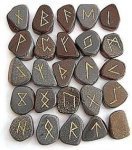 I have always been interested in Runic symbols and they seemed like the perfect script to use in the Moon Stealer books. I wanted to create a primative feeling of age as well as wisdom.
I have always been interested in Runic symbols and they seemed like the perfect script to use in the Moon Stealer books. I wanted to create a primative feeling of age as well as wisdom.
Runic inscriptions have appeared since the first century when they were etched on objects for practical as well as magical purposes. They have been used as an Oracular device (used to predict the future), as magical symbols, calendars, riddles and poems. They also had practical uses as the marks or signatures of tradesman and stonemasons.
Interestingly, some of the modern English language has origins in Runes. The letter  called Feoh means Fee in English, still used to denote a debt.
called Feoh means Fee in English, still used to denote a debt.
Even the shape of the Runes has symbolic meaning today. The rune means desire and is the ‘fingers crossed’ symbol we use when we hope (or desire) something.
rune means desire and is the ‘fingers crossed’ symbol we use when we hope (or desire) something.


January 27, 2013
The Moon Stealer Logic Puzzle
To keep the children amused on the train coming back from Edinburgh, Sir Edgar devised a little puzzle for them. See if you can work it out.


January 25, 2013
Donestre – The Faerie Queen’s Bounty Hunter
 Whilst researching mythical creatures for the second Moon Stealer book, I came across a small piece of information about a creature called a Donestre, as well as a couple of pictures. I was looking for a fearsome creature that would make a formidable warrior for the Faerie Queen.
Whilst researching mythical creatures for the second Moon Stealer book, I came across a small piece of information about a creature called a Donestre, as well as a couple of pictures. I was looking for a fearsome creature that would make a formidable warrior for the Faerie Queen.
In ancient times, they were thought to have been found by the Greek, Alexander the Great and appeared in various medieval manuscripts (Bestiary’s) including the Wonders of the East. They were reported to be monsters that greeted unsuspecting travellers in their local tongue. They then killed and ate them, leaving just the head which they sat and wept over.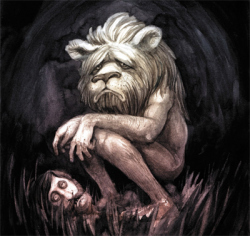
My Donestre are bounty hunters employed by the Faerie Queen. They are skilled Polyglots (able to speak in different languages, including dead languages). They have excellent senses and are athletic runners, on all fours as well as two legs. They are commonly between 6 to 7 foot tall, with the body of a man and the head of a lion. To match their formidable size, they needed an enhanced weapon, so I equipped them with an overly long and wide hooked sword which was secured in a leather harness across their back.
(Modern illustration of a Donestre by Kevin Cornell. Visit http://www.v5.bearskinrug.co.uk/ for some great artwork)


January 24, 2013
Opening the door to another world
In the first book of the Moon Stealer series, Sir Edgar and the children use the Silver Bough to open a portal into another world. This may seem a little far-fetched, but even in reality there have been reports of gateways through to other worlds.
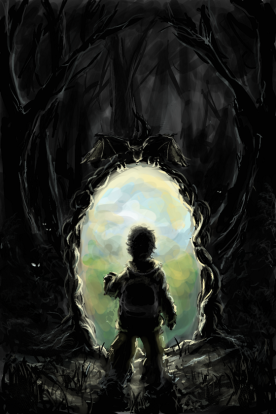 There have been numerous reports of portals into other worlds, some closely linked to the Arthurian legend. BroceliandeForest in Brittany, for example, where Merlin advised King Arthur over the Holy Grail, is believed to be one such portal. Even Stonehenge, which has been mentioned as another possible location for Camelot, was also thought to be a gateway. There have been several reports of people entering another world within the mountains of Pech de Bugarach near Bugarach, in the south of France, as well as the nearby ruined chateau of Miglos.
There have been numerous reports of portals into other worlds, some closely linked to the Arthurian legend. BroceliandeForest in Brittany, for example, where Merlin advised King Arthur over the Holy Grail, is believed to be one such portal. Even Stonehenge, which has been mentioned as another possible location for Camelot, was also thought to be a gateway. There have been several reports of people entering another world within the mountains of Pech de Bugarach near Bugarach, in the south of France, as well as the nearby ruined chateau of Miglos.
If portals that lead to other worlds could exist, then the existence of other worlds themselves would also need to be possible. The ‘Many worlds’ theory has been scientifically explored in the form of alternative histories, as mentioned by Hugh Everett in 1957, then later by Bryce Seligman DeWitt. These alternative histories are viewed like a many branched tree where every possible outcome from our past happened in another universe, leading to an infinite number of universes.
There has also been the idea that our world runs parallel to another and that we cross an endless number of other worlds. At some of the crossing lines our worlds collide and can accidentally penetrate each other.
Picture by fromzertohero at http://fromzerotohero.deviantart.com/


January 22, 2013
Setting the Scene – Edinburgh Castle, Scotland
With most of my books I try and include real locations as part of the story. To me they are just as important as the characters that drive the book forward on their journey of development. They also provide a visual backdrop that the reader can imagine, or even go on the web and research.
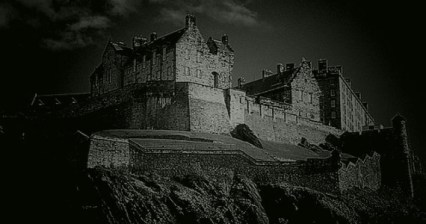 One of the locations I used in the first Moon Stealer book was Edinburgh Castle (MS#1:Ch15). This was for several reasons – it had history, presence and intrigue. Research only added to these reasons.
One of the locations I used in the first Moon Stealer book was Edinburgh Castle (MS#1:Ch15). This was for several reasons – it had history, presence and intrigue. Research only added to these reasons.
Edinburgh Castle sits on top of extinct volcanic rock and has some reference to being occupied dating all the way back to the 2nd Century AD, although, of course, the castle has been changed and added to since then. Such an ancient building with a defined history fitted in perfectly with a back story I needed for one of King Arthur’s Knights, Sir Hadwyn. It has also been reported as being one of the possible locations for Camelot, King Arthur’s castle, in fact even to this day the rock is sometimes known by the nickname Arthur’s Seat.
There have always been rumours that EdinburghCastle had a networ k of secret tunnels that stretched even as far as HolyroodhousePalace at the end of the Royal Mile, but these unfortunately have not proved to be true. However, there are vaults beneath the castle, but the only tunnel is a private entrance for the army to enter whilst avoiding the tourists.
k of secret tunnels that stretched even as far as HolyroodhousePalace at the end of the Royal Mile, but these unfortunately have not proved to be true. However, there are vaults beneath the castle, but the only tunnel is a private entrance for the army to enter whilst avoiding the tourists.
The location of the castle is also perfectly placed to include other ancient and intriguing buildings – perfect for a short quest within the city of Edinburgh.
I appreciate this post is brief, but there is so much information about Edinburgh Castle and it’s history on the internet – well worth a look.


January 21, 2013
Faerie or Fairy?
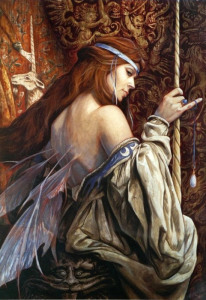 Some people have asked me about the use of the word Faerie in The Moon Stealer series and why I hadn’t spelt it Fairy?
Some people have asked me about the use of the word Faerie in The Moon Stealer series and why I hadn’t spelt it Fairy?
I my mind the word Fairy conjures up a more ‘disney’ like image of small winged human type creatures that fly. It’s all a lovely, cosy image and I wanted to distance my readers from this image by using a different spelling. I wanted my Faeries to have a slightly different image, in my mind they were overly beautiful human sized people who could perform magic, good and bad. A more historical Faerie from ancient times and cultures was what I wanted and it fitted in better with the inclusion of the Arthurian legend within the books.
In some folklore, Faeries were dead or demonic creatures or simply the spirits of the dead. They lived underground, or in another world. This Otherworld is closely associated with Avalon, the island where King Arthur was reported to have gone after being mortally wounded, taken by four faeries until he is needed once more. The Silver Bough was said to allow mortals to pass through into this Otherworld. Faeries were often known to be shape shifters too, skilled in magic that related to the elements (Earth, Water, Wind, Fire) and if they did fly, it was usually on the backs of birds.
There’s more to Fairies than tiny humanoid sized beings with insect-like wings and trails of magic dust.
(Illustration by the brilliant artist Brian Froud)





